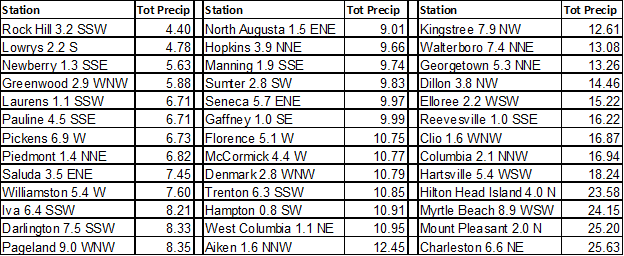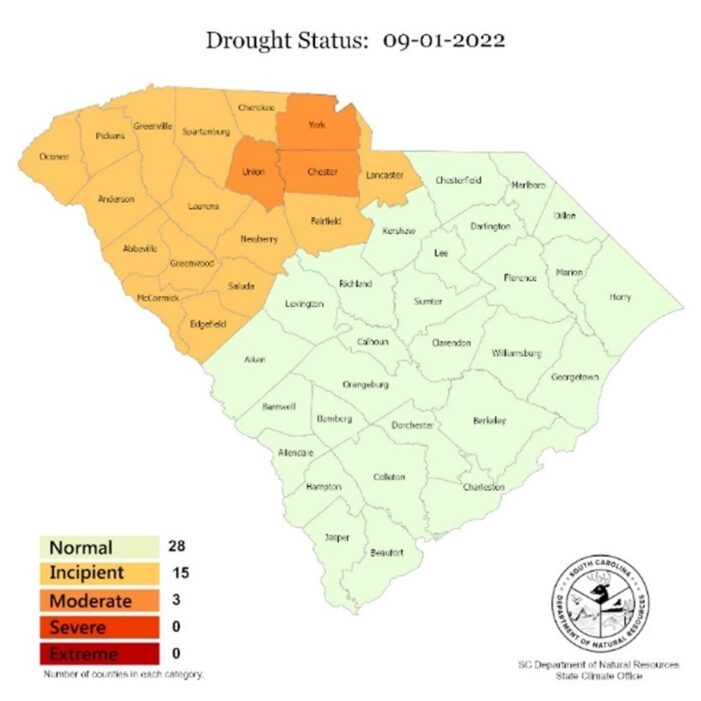| The S.C. Drought Response committee downgraded the drought status for 10 counties during its meeting Sept. 1.Higher than normal rainfall prompted the S.C. Drought Response Committee to downgrade the drought status for 10 counties in the coastal plain of South Carolina during a meeting Sept. 1 via conference call.Fourteen counties remain in incipient drought: Abbeville, Anderson, Cherokee, Edgefield, Fairfield, Greenville, Greenwood, Laurens, McCormick, Newberry, Oconee, Pickens, Saluda, Spartanburg. Lancaster was upgraded to incipient and three counties — Chester, Union and York — were upgraded to moderate. As designated by the South Carolina Drought Response Act, incipient is the first level of drought followed by moderate, severe and extreme.The decision to upgrade York, Chester and Union counties was primarily based on very low rainfall totals and the effect on agriculture.“Much of the state is doing well for crop production and pasture health,” said Katherine Helms, marketing specialist for cotton, tobacco and pork at the S.C. Department of Agriculture. “Unfortunately, this is not the case for Chester, Union, and York Counties, particularly due to limited rainfall over the last 60 days, which has affected both row crops and pastures. Some producers from this area have noted that their cotton will not be able to be harvested.“Rainfall over the last 60 days as reported by a network of volunteer observers, the Community Collaborative Rain, Hail and Snow Network, shows a wide range from less than 5 inches in York and Chester counties to more than 25 inches in Berkeley, Charleston and Horry counties (see table below). While some counties remaining in incipient drought received adequate rain, other areas seemed to keep missing the summer showers and led the committee to maintain the incipient status.There was further support for the committee’s decision based on streamflow and groundwater conditions.Rainfall during the past month improved streamflow in the Midlands and coastal counties, according to Priyanka More, S.C. Department of Natural Resources hydrologist. However, the north and northwest regions of the state did not receive enough rain during the past month to replenish the groundwater.The York County well observed a drop in the groundwater levels beginning in late June and has never recovered. Also, the streamflow at Rocky Creek in the Chester County was recorded at levels well below its typical 14-day average. This supports moderate status in York, Chester and Union counties while maintaining the incipient status in the rest of the Upstate counties.The S.C. Forestry Commission reported to the committee that recent rain and higher humidity has reduced the wildfire threat in many areas across the state.The S.C. Emergency Management Division had not received any drought impact reports, and there has been no water supply or water quality issues reported to SCDNR or the S.C. Department of Health and Environmental Control.The S.C. State Climatology Office will continue to monitor conditions and the Drought Response Committee will reconvene in four to six weeks.Media contacts:Hope Mizzell, SCDNR State Climatology Office, MizzellH@dnr.sc.govPriyanka More, SCDNR Hydrology, MoreP@dnr.sc.govJoe Koon, SCDHEC, KoonJm@dhec.sc.govDarryl Jones, S.C. Forestry Commission, Djones@scfc.govChad Truesdale, S.C. Department of Agriculture, CTruesd@scda.sc.gov Community Collaborative Rain, Hail and Snow NetworkRainfall July 3 – Aug. 31, 2022  South Carolina Department of Natural Resources, Rembert C. Dennis Building South Carolina Department of Natural Resources, Rembert C. Dennis Building1000 Assembly Street, Columbia, SC 29201Department Phone Numbers |

